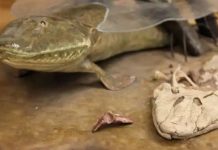How do you sit on your nest of eggs when you weigh over 1,500kg?
Carefully – according to a new study from an international team of researchers in Asia and North America.
The idea was to stack the eggs around themselves in the form of a spiral, National Geographic reported. Bird-like dinosaurs, aka oviraptorosaurs, used to create donut like formations with oval-shaped eggs in their nests. The size of these formations depended on the size of the dinosaur, which meant if a dinosaur was humongous, the diameter of its egg-ring would be larger and the opposite if the animal was small in size.
The unique brooding behavior came into notice when Darla Zelenitsky from the University of Calgary and colleagues took a close look at as many as 40 oviraptorosaur nests, with fossilized eggs, dating back to the period between 100 and 70 million years ago. According to a report in Live Science, the animals had parrot-like heads, toothless beaks, were way bigger than the largest modern-day birds and weighed up to a whopping 4,000 pounds.
The difference in their size was evident from their nests, as in some cases, the nests measured around 16 inches across and the egg-rings had no to little space, while in other cases, the nest went up to a whopping 11 feet wide with rings that had more space in the center. This indicated that even bigger dinosaurs could settle in and rest their weight on the nest without crushing the eggs.
“Oviraptorosaurs appear to have adapted to being able to sit on their clutches, even at giant body size,” Zelenitsky told Live Science. “This egg-free opening in clutches became larger with increasing species size. In the largest species, the opening, rather than the eggs, occupied most of the clutch area.”
That said, the weird behavior of the dinosaurs also raises a question on the sole reason behind this exercise. Birds sit on their eggs to keep them warm, but it is possible that oviraptorosaurs did this for a completely different reason such as protection. The researchers do not know the exact motivation as of now, but they noted in the study that if the technique is for keeping the eggs warm, then it may have been less effective due to lesser contact with them.















